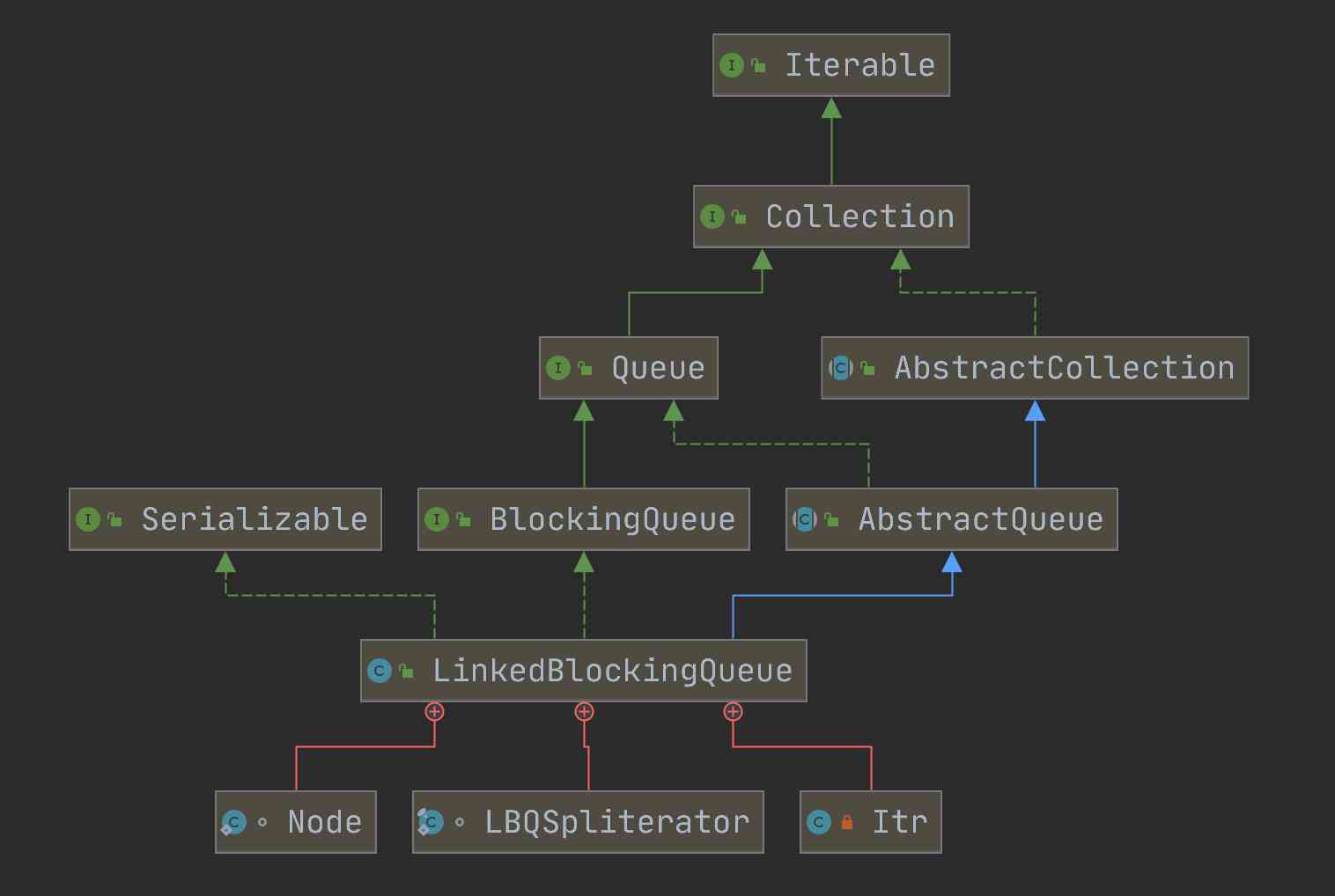前言
上一节看了基于数据的有界阻塞队列 ArrayBlockingQueue 的源码,通过阅读源码了解到在 ArrayBlockingQueue 中入队列和出队列操作都是用了 ReentrantLock 来保证线程安全。下面咱们看另一种有界阻塞队列:LinkedBlockingQueue。
公众号:『 刘志航 』,记录工作学习中的技术、开发及源码笔记;时不时分享一些生活中的见闻感悟。欢迎大佬来指导!
介绍
一个基于链接节点的,可选绑定的 BlockingQueue 阻塞队列。
对元素 FIFO(先进先出)进行排序。队列的头部是已在队列中停留最长时间的元素。队列的尾部是最短时间出现在队列中的元素。将新元素插入队列的尾部,并检索队列操作获取队列开头的元素。
基于连表的队列通常具有比基于数组的队列有更高的吞吐量,但是大多数并发应用程序中的可预测性较差。
基本使用
public class LinkedBlockingQueueTest {
private static final LinkedBlockingQueue<String> QUEUE = new LinkedBlockingQueue<>(10);
public static void main(String[] args) throws InterruptedException {
// 入队列
QUEUE.put("put 入队列, 队列满则会阻塞等待");
QUEUE.add("add 入队列, 队列满则会抛出异常");
QUEUE.offer("offer 入队列, 队列满会返回 false");
// 出队列
// 队列空返回 null
String poll = QUEUE.poll();
// 队列空会阻塞等待
String take = QUEUE.take();
// 仅仅看一下最早入队列的元素
String peek = QUEUE.peek();
}
}
问题疑问
- LinkedBlockingQueue 的实现原理是什么?
- LinkedBlockingQueue 和 ArrayBlockingQueue 的区别是什么?
源码分析
基本结构

参数介绍
static class Node<E> {
E item;
/**
* One of:
* - 真正的后继节点
* - 有值,表示后继者是head.next
* - null,表示没有后继(这是最后一个节点)
*/
Node<E> next;
Node(E x) { item = x; }
}
首先在 LinkedBlockingQueue 中有一个静态内部类 Node
/** 初始容量,如果没有,则为Integer.MAX_VALUE */
private final int capacity;
/** 当前元素数 */
private final AtomicInteger count = new AtomicInteger();
/**
* 链表头
* 不变的是: head.item == null
*/
transient Node<E> head;
/**
* 链表尾
* 不变的是: last.next == null
*/
private transient Node<E> last;
/** 执行 take, poll 等操作需要获取到 takeLock */
private final ReentrantLock takeLock = new ReentrantLock();
/** 等待执行 take 操作的线程,会放入这个条件队列 */
private final Condition notEmpty = takeLock.newCondition();
/** 执行 put, offer 等操作需要获取到 putLock */
private final ReentrantLock putLock = new ReentrantLock();
/** 等待执行 put 操作的线程,会被放入这个条件队列 */
private final Condition notFull = putLock.newCondition();
构造函数
public LinkedBlockingQueue() {
this(Integer.MAX_VALUE);
}
// 创建时指定容量
public LinkedBlockingQueue(int capacity) {
if (capacity <= 0) throw new IllegalArgumentException();
this.capacity = capacity;
last = head = new Node<E>(null);
}
通过构造函数可以看出,在初始化 LinkedBlockingQueue 时,如果不传入容量则会默认指定 Integer.MAX_VALUE。
添加元素
add 方法是直接调用的父类 AbstractQueue 的方法,内部调用的 LinkedBlockingQueue 自己实现的 offer 方法
public boolean add(E e) {
if (offer(e))
return true;
else
throw new IllegalStateException("Queue full");
}
主要阅读的还是 LinkedBlockingQueue 的 put 和 offer 方法:
public void put(E e) throws InterruptedException {
// 插入元
if (e == null) throw new NullPointerException();
// Note: 所有put / take / etc中的约定是预设本地变量
// 保持计数为负表示失败,除非置位。
int c = -1;
Node<E> node = new Node<E>(e);
final ReentrantLock putLock = this.putLock;
final AtomicInteger count = this.count;
putLock.lockInterruptibly();
try {
// 如果已经到最大容量,则等待
while (count.get() == capacity) {
notFull.await();
}
enqueue(node);
// 总数进行增加, 返回的是先前的容量
c = count.getAndIncrement();
// 判断是否需要唤醒入队列阻塞的线程
if (c + 1 < capacity)
notFull.signal();
} finally {
putLock.unlock();
}
if (c == 0)
// 唤醒因调用 notEmpty 的 await 方法而被阻塞的线程
signalNotEmpty();
}
public boolean offer(E e) {
// 为空抛出异常
if (e == null) throw new NullPointerException();
final AtomicInteger count = this.count;
// 如果已经到最大容量,返回 false
if (count.get() == capacity)
return false;
int c = -1;
Node<E> node = new Node<E>(e);
final ReentrantLock putLock = this.putLock;
putLock.lock();
try {
if (count.get() < capacity) {
enqueue(node);
c = count.getAndIncrement();
if (c + 1 < capacity)
notFull.signal();
}
} finally {
putLock.unlock();
}
if (c == 0)
signalNotEmpty();
return c >= 0;
}
通过上面两段代码可以看出 put 和 offer 的最大区别在于是否阻塞。 put 方法当队列达到指定容量时,会阻塞,等待有元素出队列。而 offer 方法会直接返回 false。
同时两个方法操作元素入队列都是调用的 enqueue(node) 方法,下面一起看下 enqueue 方法。
private void enqueue(Node<E> node) {
// assert putLock.isHeldByCurrentThread();
// assert last.next == null;
last = last.next = node;
}
在 enqueue 方法中,直接指定当前尾节点的 next 为传入的元素即可。
获取元素
public E poll() {
final AtomicInteger count = this.count;
// 队列为空返回 null
if (count.get() == 0)
return null;
E x = null;
int c = -1;
// 加锁
final ReentrantLock takeLock = this.takeLock;
takeLock.lock();
try {
if (count.get() > 0) {
x = dequeue();
// 减少队列元素计数,返回的是旧值
c = count.getAndDecrement();
if (c > 1)
// 旧值大于 1 ,就是当前大于 0
// 唤醒调用 notEmpty.await 等待的线程
notEmpty.signal();
}
} finally {
takeLock.unlock();
}
if (c == capacity)
// 如果旧值等于 capacity 说明当前空了一个位置
signalNotFull();
return x;
}
public E take() throws InterruptedException {
E x;
int c = -1;
final AtomicInteger count = this.count;
final ReentrantLock takeLock = this.takeLock;
takeLock.lockInterruptibly();
try {
// 阻塞等待
while (count.get() == 0) {
notEmpty.await();
}
x = dequeue();
c = count.getAndDecrement();
if (c > 1)
notEmpty.signal();
} finally {
takeLock.unlock();
}
if (c == capacity)
signalNotFull();
return x;
}
通过上面代码可以看出 poll 和 take 方法逻辑大致相同。区别就是在当前队列为空时的处理逻辑。poll 在当前队列为空时返回 null,take 会阻塞等待,知道当前队列中有元素。
poll 和 take 都试用 dequeue() 方法从队列中获取元素。
private E dequeue() {
// assert takeLock.isHeldByCurrentThread();
// assert head.item == null;
Node<E> h = head;
Node<E> first = h.next;
h.next = h; // help GC
head = first;
E x = first.item;
first.item = null;
return x;
}
dequeue() 方法逻辑就是获取头节点,并将 head 指向下一个节点。
查看元素
public E peek() {
if (count.get() == 0)
return null;
final ReentrantLock takeLock = this.takeLock;
takeLock.lock();
try {
Node<E> first = head.next;
if (first == null)
return null;
else
return first.item;
} finally {
takeLock.unlock();
}
}
peek() 方法比较简单,直接获取 head 的元素值即可。
总结
Q&A
Q: LinkedBlockingQueue 的实现原理?
A: LinkedBlockingQueue 是基于链表实现的,内部使用 ReentrantLock 互斥锁,防止并发放置元素或者取出元素的冲突问题。
- take、poll、peek 等从队列中获取元素的操作共用 takeLock 锁。
- add、put、offer 等向队列中添加元素的操作共同 putLock 锁。
- notEmpty 和 notFull 是 Condition 类型,在 take 和 put 操作时,如果如果队列为空或者队列已满,会调用相应的 await 将线程放入条件队列。
Q: 入队列和出队列方法之间的区别是什么?
| 方法 | 作用 |
|---|---|
| add | 添加元素,队列满了,添加失败抛出异常 |
| offer | 添加元素, 队列满了,添加失败,返回 false |
| put | 添加元素,队列满了,阻塞等待 |
| poll | 弹出元素,队列为空则返回 null |
| take | 弹出元素,队列为空则等待队列中有元素 |
| peek | 查看队列中放入最早的一个元素 |
结束语
LinkedBlockingQueue 使用和 ArrayBlockingQueue 并没有什么区别,内部实现都是使用的 ReentrantLock,可以对照着阅读。同时 Condition 这块也需要着重了解一下。

